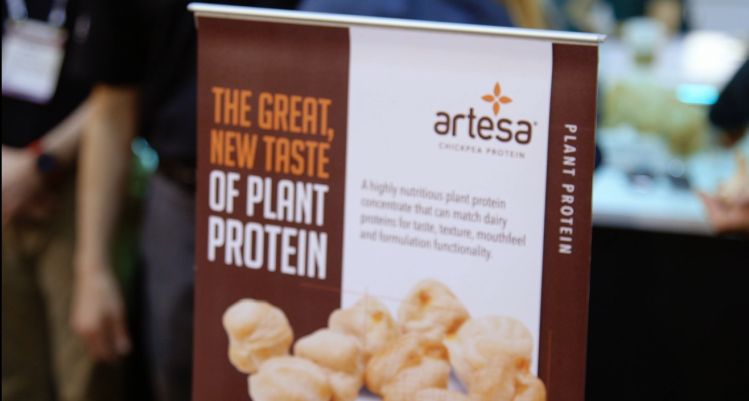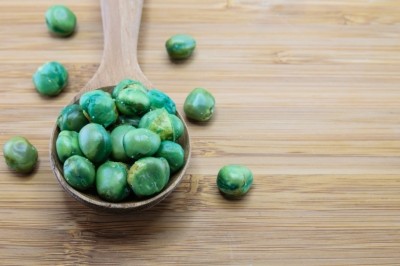Chickpeas: The next big protein source for plant-based meat? Nutriati unveils TVP

Successive speakers at the Good Food Institute’s (GFI’s) Good Food Conference in San Francisco last week bemoaned the limited toolbox available to plant-based meat formulators, with Impossible Foods and Beyond Meat both highlighting the need for a more “diverse palate of crops to work with.”
Finding more scalable sources of protein suitable for plant-based meat production is arguably “the biggest challenge facing the industry today,” GFI director of science and technology Dr David Welch told FoodNavigator-USA, noting that finding viable, scalable plant proteins that perform well through extrusion or other processing technologies that re-wire their protein structures to create textures that mimic meat is an ongoing challenge.
“We have commercialized the world’s first textured vegetable protein with chickpeas through a dry [extrusion] process [with less than 8% moisture] for things like burgers and sausages,” Nutriati CEO Michael Todd told us from the sidelines of the conference.
“And we’re in the late stages of developing a high moisture meat analog [via a wet extrusion process] with around 70% moisture, which will be focused on seafood, pork and poultry markets and shipped through the cold chain.
“We’ve worked with key OEMs [original equipment manufacturers] this year and conducted three trials with the most recent manufacture two months ago. We’ve shared samples with legacy brands looking for new protein sources and new entrants into the plant-based meat category and we’re going into a consumer trial soon.
“We decided at the start of this year that dairy-free and plant-based meats are where we’re going to put a ton of focus and we expect to see product on the market if not in the fourth quarter of this year, then in early 2020.”
The price for commercial quantities, he said, would be “right in line with textured pea protein,” while sodium levels would also be lower than in some high-profile plant-based burgers made with soy and pea.
‘The functionality is completely different than what you’d get with a typical chickpea flour’
Thanks to a patent-pending proprietary production process, Nutriati’s chickpea protein has a small, uniform particle size that delivers a clean, neutral taste and aroma, superior mouthfeel and appearance, and helps it beat plant-based rivals in the functionality stakes, delivering superior water and oil binding qualities, freeze/thaw stability, solubility/dissolution and suspendibility, allowing for higher inclusion levels and shorter, cleaner labels in multiple food and beverage applications, said co-founder Michael Spinelli.
“People have attempted to make TVP with chickpeas before,” said Spinelli, a food R&D veteran who rose up the ranks at Ben & Jerry’s and Sabra before forming Nutriati in 2013.
“But the OEMs that we’ve been working with have been very encouraged with the results we’ve seen in our tests. The functionality is just completely different than what you’d get with a typical chickpea flour. It’s robust, it’s not mushy or soft, it holds up, and it’s not super rubbery. It’s also not one of the big eight allergens and it’s a sustainable protein source.
“We’re really raising the bar on the ingredients side to allow companies to take that next iteration [of the plant-based burger] higher. Our chickpea proteins have native protein and native starch granules, not denatured protein, so when they go to the extruder, they are very active and their oil and water binding capacity is quite high, so we can create TVP with just our protein concentrate and no other additives.”
No need for methyl cellulose?
He added: “Oftentimes, pea fiber is used or other combinations of proteins or even tapioca starch is added, but as we have the fiber and protein and some native starch in our protein concentrate, we’re able to use it as a single ingredient, or we can modulate texture by adding our chickpea flour as well, which can bring a different dimension to the TVP.”
One particularly appealing aspect to the chickpea protein is that it’s also possible to make burgers without adding methyl cellulose - an ingredient with attractive gelling and emulsifying capabilities, but a not very consumer-friendly name - that is found in all the leading plant-based meat brands including the Beyond Burger and the Impossible Burger, he noted.
“We have had success with burgers and sausage patties and sausage links and crumbles with the core ingredients of our TVP in combination with our gluten-free flour, which deliver gelation properties, oil binding, expansion in water and texturization, as well as the nutritive value.”

Chickpea yogurt
Nutriati is also seeing encouraging results with applications work testing its chickpea proteins and flours in dairy alternatives, notably yogurts, which deliver a superior protein content and texture vs many nut or coconut-based products on the market, said Spinelli.
“Often these products are loaded with sugar and low in protein without a great texture, but we’ve created something that can rival dairy on the nutrition side.”
Chickpea milk
In a recent trial, Nutriati created a silky chickpea milk with 8g protein, 1g fat and 3g fiber per serving, he said, noting that chickpea protein is particularly appealing to formulators because it has a “very light color, and the flavor profile is so neutral that it can be a foundational ingredient for many applications across categories.
“You can make a chickpea milk that’s very white in color and smooth and silky. We find that masking agents are not necessarily required in many applications because of the neutrality of flavor, whereas with other sources of protein you have color issues to contend with, and [issues with] granulation size, or precipitation of those proteins in certain applications.”
Speaking to FoodNavigator-USA at the IFT annual meeting and expo in New Orleans over the summer, he added: “Another part of our process is focused on creating a very fine and consistent particle size, which leads to very strong dispersibility and suspensibility in emulsions. So we have the emulsification coupled with the small particular size that leads to very slow sedimentation in liquid applications, so we can create ice cream and cultured products such as yogurts and cheeses and you don’t get that sandy or gritty mouthfeel from a precipitated protein, because the particle size is so small."

PDCAAS score
As for nutrition, he said, artesa chickpea protein has around 62% protein, 14% fiber, 19% complex carbs, 4% minerals and ash, and 1% oil (making for good stability).
While it is not a complete protein like soy, egg, or casein, it is a high quality concentrated protein source with a digestibility score of 93% and a PDCAAS of 0.82 – at the top end of the scale for plant-proteins, said Spinelli.
“We have a process that’s very novel and we retain all of the amino acids, and we have a PDCAAS of 0.82, so we’re pretty happy with that as far as plant proteins go.”
The size of the prize
So could chickpea protein be as big as pea, or even soy, protein?
“Absolutely,” insisted Todd. “We have patents on the technology, and other patent filings, and we designed the process to be fully scalable and transferable as needed to other regions around the world, and on the procurement side chickpeas are grown globally in many different areas around the world.”
























